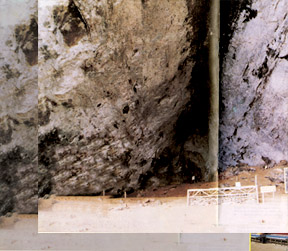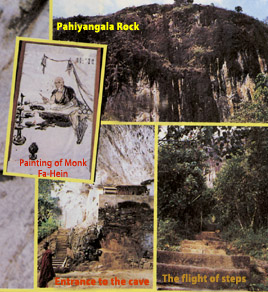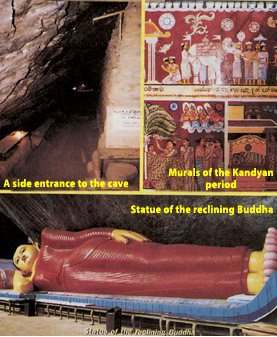A wonderful creation of Mother Nature
 Pahiyangala, the largest cave in Asia, is situated at Bulathsinhala
in the Kalutara District. It is a two hour drive from Colombo through
the Piliyandala-Horana Road and covers a distance of about 40 Km. The
road is motorable up to the foot of the rock. Pahiyangala, the largest cave in Asia, is situated at Bulathsinhala
in the Kalutara District. It is a two hour drive from Colombo through
the Piliyandala-Horana Road and covers a distance of about 40 Km. The
road is motorable up to the foot of the rock.
Pahiyangala gets its name from the famous Chinese traveller monk, Fa
Hein who came to this country in the 4th century A. D. in search of
Buddhist scriptures. He is said to have stayed in this cave whilst on
his way to Sri Pada (Adam's Peak).
Pahiyangala is a huge rock about 300 feet in height which has a
flight of about 1,000 steps. It is a wonderful creation of Mother
Nature. At the foot of the rock, there is a Buddhist temple, recently
constructed. The rock is covered by thick jungle. The stairway is very
steep and is not in good repair in certain places. Nevertheless, the
trip is an unforgettable experience.
The cave, as it is seen today, is partially covered by a cave temple
which has two parts. Towards east, there is a small, but ancient image
house, which belongs to the Kandyan period. The structure shows signs of
subsequent renovations. In the centre, there is a large statue of the
reclining Buddha, built recently.
 Towards the western side of the cave, the Department of Archaeology
had carried out excavations and, had discovered evidence of ancient
human settlements dating back to some 32,000 odd days. The cave which
can hold about 1,000 inhabitants easily had been used by the aborigines
of this country for several generations. Towards the western side of the cave, the Department of Archaeology
had carried out excavations and, had discovered evidence of ancient
human settlements dating back to some 32,000 odd days. The cave which
can hold about 1,000 inhabitants easily had been used by the aborigines
of this country for several generations.
Their implements, the shells of snails believed to have been eaten by
them as well as the remnants of animal bones are on display at the site.
The human skull that was found here had been taken to the Department of
Archaeology in Colombo.
These settlements form a part of the famous 'Balangoda Man' - Homo
Sapien Sapien, but are much older than that. The skeleton found here is
considered to be the oldest one of the present man, that has come to
light so far in South Asia.
The people who lived in the cave were basically hunters. But the
archaeologists have found evidence of fire being used for cooking.
The above goes to show that our history certainly started long before
the arrival of Prince Vijaya from India 2,500 years ago.
 The scenery one sees from the cave is marvellous. One could see many
miles of verdant tree tops. Although the original rain forests are no
more, Kitul palms, Na trees and commercial plantations such as rubber
and coconut can be seen everywhere. It is amazing to imagine how our
forefathers lived in this cave, as hunters and food gatherers, feasting
on animals such as wild boar. The scenery one sees from the cave is marvellous. One could see many
miles of verdant tree tops. Although the original rain forests are no
more, Kitul palms, Na trees and commercial plantations such as rubber
and coconut can be seen everywhere. It is amazing to imagine how our
forefathers lived in this cave, as hunters and food gatherers, feasting
on animals such as wild boar.
The cave itself, is a wonder which could be over 100 metres across
the bottom. At the highest point, it is over 100 metres from top to
bottom. The aborigines must have found shelter in the cave during the
rainy season. The cave is now half-covered with sedimentary rocks and
soil accumulated over thousands of years. Archaeologists had to dig up
to about 30 feet to get to the bottom of the cave.
We visited Pahiyangala recently. Our group consisted of two families;
five adults and three children. We left Colombo at about 7.00 a.m. and
reached Pahiyangala by 9.00 a.m.
After climbing the rock, we came down by about 10.30 a.m. and had a
dip in the nearby stream. We bought pure Kitul jaggery and vegetables on
the way. We had tea and short-eats by the stream and came to Horana for
lunch.
Pahiyangala is a place which should be visited by the nature lovers
as well as the students of history alike.
Courtesy Explore Sri Lanka
|
